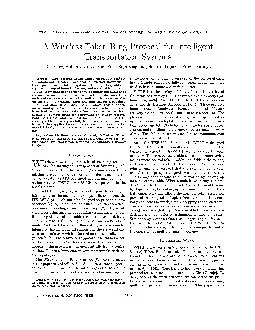/


It supports quality of service in terms of bounded latency and reserved bandwidth WTRP is efficient in the sense that it reduces the number of retransmissions due to collisions It is fair in the sense that each station takes a turn to transmit and i ID: 29338
Download Pdf The PPT/PDF document "IEEE Intelligent Transportation Systems ..." is the property of its rightful owner. Permission is granted to download and print the materials on this web site for personal, non-commercial use only, and to display it on your personal computer provided you do not modify the materials and that you retain all copyright notices contained in the materials. By downloading content from our website, you accept the terms of this agreement.
Intelligent Transportation Systems Conference Proceedings Oakland (CA) USA August 25-29, 2001 Ring Protocol Sengupta, Stavros Tripakis, Pravin medium access control protocol wireless networks in Intelligent Transportation bounded latency and retransmissions due collisions. It is fair in sense that takes a turn transmit after transmitting each node token frame. frame. FC I RA I DA I SA I Seq I GenSeql 1 6 6 6 4 4 bytes FC stands for Frame Control Token, Solicit In addition, addresses (DA), ring ring address to the token belongs. generation sequence number Connectivity manager each node sequence number Connectivity Manager builds comes back to E. sequence number transmits the sequence number transmission from transmission from sequence number been increased were two not hear Ring Owner the station address. A ring address rely on token transmissions. An implicit heard after ring address implicit acknowledgement. no implicit acknowledgement multiple tokens but one), ring address A token sequence num- accepted or a token without accepting it can that the protocol deletes more tokens tokens lo]. The ring recovery mechanism is invoked when recover from possible. Using Connectivity Manager, quickly find nected node in station then next connected rotation time (sum token holding per node, plus overhead such would not grow unacceptably with ring. Let us also trol manager on station Manager waits the SETSUCCESSOR transmission time. ring, such random slot winners. Suppose node passes C, the host node joining process concludes. shown in can hear cannot hear next con- order, and In Figure ring address a ring any one In the ring A that the ring address coming from present in owner leaves ring address ring owner. protocol deals case where owner leaves ring without ring owner token without token ring protocol on PCMCIA card card protocol in DCF (Distributed Coordinated Function) mode. This is done by prepending the token ring broadcasting all all Layer I Fig. 5. Software Architecture the IEEE802.11 link. The implementation of the Wireless Token Ring Protocol is divided into three parts: user-space module. network layer PCMCIA card. passes from from to implement WTRP. Teja allows developers to specify a design in a concurrent finite-state chines design. have linked to the operating system, Linux kernel distribution) and 3.1.7 respec- respec- driver to implement our token ring driver. V. PERFORMANCE The effective raw bandwidth using was measured shown in a large size 5830080 Bytes was transferred between two nodes run- token ring medium access rotation time was measured was done concurrent transfers, concurrent transfers. three peaks transmission periods. one can that the rotation time did not increase in transfer took direct proportion ring protocol. test results Time (Two trials are response can be nodes in mean token time increases nodes in shown in Figure time. Figure done with was from For single trial with three concurrent trans- fers, achieving LINUX clock resolu- resolu- BO 15 U. 01 0 05 0 10 11 12 13 14 15 16 17 18 19 12 13 15 16 17 18 19 21 22 Comparing Figure that the more precise, the standard tation time as a function rate, the a large number promising since, small number the standard increased linearly. implemented on incurring all associated with IEEE802.11 plus token ring. packet header shown in plotted against cases involved was formed case of simultaneous transfers, another from three simultaneous Figure 12, solid line . . . . . Rotation Time Rotation Time ring protocol. least with were involved, observed a decrease. decrease in performance surprisingly improves in ring case when can be simultaneous transfers, transmissions per token on increasing per token data to need for eliminated since ring actually , , , topology, meaning slave nodes network since management information can a single node failure one can achieve higher platooning example[6]. In the platooning application, our ring topology, one does not ring increases[9]. Fig. 13. Vehicular connection between all slaves, subnets and performance results token ring good. Even ring protocol implemented on mode, incurring IEEE802.11 plus ring protocol, that the heavy load. interfering nodes increases. testing platform being built have designed a protocol were several cache in each performance results also a software when utilized network interface simultaneous transmissions is key access latency. This perhaps ring protocol, in real time applications and au- systems. In fact, IEEE802.4 was people from and other companies interested in factory factory It has been established protocol within General Motor’s manufacturing manufacturing Features such multiple node the same bounded latency robustness features Performance Radio Type 1; Functional Radio Equipment and systems (RES) October Martorell, L.C.; access control protocols Letonsaari, A.; Hamalainen, a new multimedia local area International Symposium Personal, In- Radio Communications, York, NY, 1998. p.592-6 on Smart Roads: Problems IEEE Transactions Automatic Control, Control Design Decision and Control, Florida, Chao Chen, vehicle-to-vehicle communzca- Master’s Thesis Thesis Duke Lee, Wireless Token Ring Protocol Master’s Thesis Thesis The Teja Technical Reference Reference WaveLAN/IEEE PCMCIA PCMCIA A. Tnanebaum, Computer Networks Prentice Hall, Lucent Technologies graduate student currently with has been detection systems, optimal research scientist communication research for intelligent received his 1998 from Grenoble, France, research position visiting researcher interests include formal Networks Distinguished